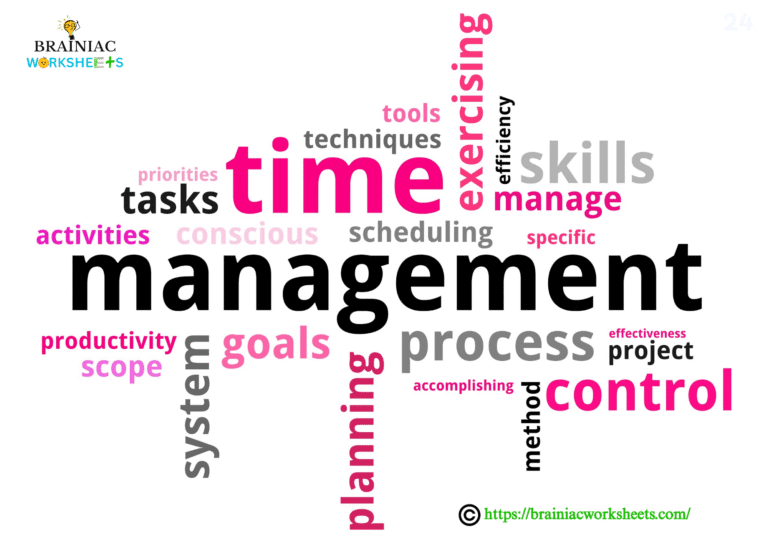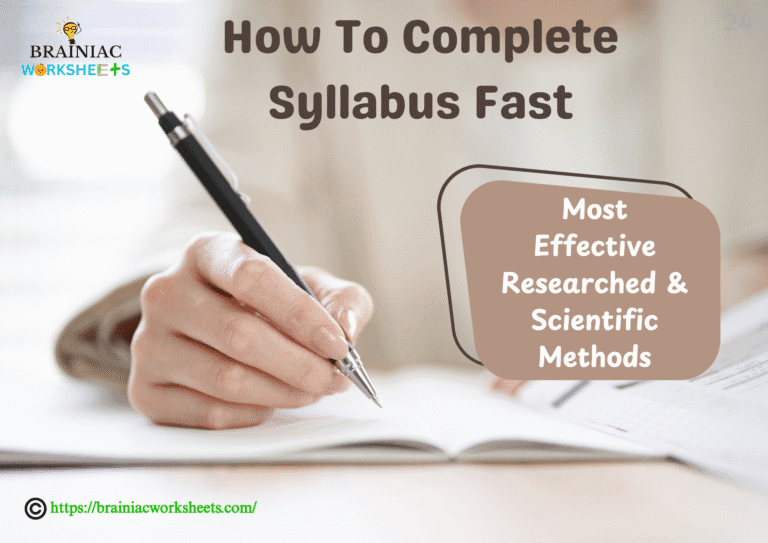You spend hours making notes, but do they help you when the exam is knocking on the door? The answer is a big ‘NO’. And that’s the reason you are reading this blog. Notes are not just mere written records; they are effective tools that help you to recall everything at a glance. Understand one thing: writing page after page without following a proper note-taking strategy will not provide the desired outcomes. It will do nothing but waste your time, leaving you stressed. Toppers don’t write much; they use effective note-taking strategies that help them during exams. After reading this blog, you will be able to make notes like toppers and won’t be worn out anymore.

Importance Of Note Taking
Notes are priceless and irreplaceable tools for understanding any topic, exam preparation, and long-term retention. Note-taking (self-written) helps you to understand, organize, and remember information actively for a longer time. It encourages you to actively engage with the study material, creating an interesting connection. They are tools that help to revise quickly during exams, saving time and reducing stress. Good notes help to recall information effortlessly during exams. Thus, it’s important to learn how to make productive notes that will give fruitful results.
How To Take Notes In the Classroom
Taking running notes in the classroom becomes messy if you don’t apply these tricks:
- Use a rough copy
- Make sure to write the date, chapter name, headings, and subheadings
- Don’t write essays, keep it precise
- Use bullets/numbering to write in points
- Make sure to write important keywords
- Write 1 line examples for every complex topic
- Listen more, write less
- Don’t switch between different inked pens; use a single pen
- Use sufficient gaps
- Check your notes after class and discuss with friends
Apply the above tricks to experience hassle-free note-taking during lectures.
How To Make Notes From a Textbook
Making notes from a textbook is a critical skill for improving effective learning and long-term retention. It’s a comprehensive strategy that is based on the SQ3R Method. The SQ3R stands for:
- Survey
- Question
- Read
- Recite
- Review
Preparation
- Understand the purpose of reading the topic/chapter. Is it for an exam, lecture, presentation, or writing an essay? Finding the ‘why’ helps you set a goal, which in turn helps you prioritize what to note.
- Survey (‘S’ of SQ3R): Read the chapter title, contents of the chapter (if available), introduction, and conclusion.
- Follow the headings, subheadings, and bold/italicized terms.
- Observe the diagrams, charts, images, and graphs.
This gives you a mental map of the chapter/topic.
Formulate Questions (‘Q’ of SQ3R)
- Transform the headings and subheadings into questions.
- Write down the questions that come to your mind during the survey.
These questions give you the purpose of reading the chapter and automatically instigate your urge to find the answers to your self-made questions.
Reading (‘R’ of SQ3R)
- Chunking: Read in chunks, which means breaking down information into manageable parts that make reading convenient (e.g., reading a few related subtopics, a few paragraphs).
- Active Reading: Paraphrase what you read in your own words. This enhances comprehensive understanding, helps you to identify learning gaps, and boosts memorization.
- Find Answers: Actively search for the answers to the questions you formulated during the survey.
- Key Information: Identify and mark the definitions, examples, keywords, important names, dates, etc.
Note-Taking
- Choose an appropriate note-taking method from the methods given below that is ideal and suitable for the subject and chapter you are learning.
- Always write the source of information in the notes page (book name, chapter name, page number).
- Write a summary of every chapter in one section of the notes if you are not using the Cornell Method.
Recite (‘R’ of SQ3R)
- Once you have completed learning and note-taking, close your book and notes. Then try to recall the main points, definitions, examples, and other significant information in your own words loudly.
- Write whatever information you can recall.
- Try to explain it to someone and mark the learning gaps.
Review (‘R’ of SQ3R)
- Fill the gaps: Fill the gaps you found while reciting, referring to your notes or textbook.
- Repeat ‘reading’ and ‘reciting’ until you understand and grasp the topic comprehensively.
- Revise regularly/frequently to reinforce learning.
In this way, you can effectively take notes from your textbook on every chapter in your syllabus.
Note-Taking Methods
Note-taking methods can be broadly classified into two categories: linear and non-linear.
The linear method of note-taking is a traditional method that follows a line-by-line sequential format where the information is presented in statement format in a chronologically structured order. Sentence Method, Cornell Method & Outlining Method are some of the linear methods of note-taking.
Non-linear method of note taking is completely different from the traditional note taking method, which doesn’t follow any strict sequence, but rather organizes information in visually friendly formats like interconnected graphs/ boxes. Methods like mind maps, flow charts, boxing, etc., are some visual methods of note-taking that emphasize connections, relationships, and interconnected branches showing complex data in a clear and easy format.
1. Sentence Method
The Sentence Method of note-taking is the most common and straightforward method that is used widely by almost every student. Here, the note is written sequentially in a formal, organized structure using headings, subheadings, bullet points, numbering, and indentation to understand categories in chronological order. The information is written in short sentences, including keywords.
How to create:
- Write the main topic right at the top center of the page using a bold ink.
- Then start writing the topics and subtopics gradually in the correct sequence using numbers.
- Maintain the margins.
- Use proper indentation to show the hierarchical order.
- Use bullets to write the details in brief points.
- Use spaces and leave lines after every topic and subtopic.
- Use abbreviations like ‘&’ for and, ‘e.g.’ for example, and so on.
- Keep it precise and concise using keywords.
- Highlight the keywords and important terms for more clarity.
Benefits:
- It is a simple, straightforward method that does not require any special skill or equipment.
- Easy to follow, logical, and sequential order.
- The appropriate method for writing detailed notes.
Compatible Subjects: Literature, Sociology, Psychology, History, Philosophy, Law, lecture and discussion notes, etc.
Caution: Sentence Notes can become lengthy, so make sure to use colorful highlighters, bullet points, numbering, and spacing to keep them precise and clutter-free.
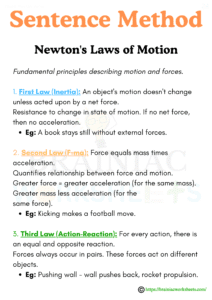
2. Mind Mapping Method
Mind Mapping of note-taking, also known as spidergram, is a non-linear visual approach where the ideas and subtopics are connected to a central topic, forming a tree-like structure. Many topics and subtopics branch out from the primary topic to complete the entire structure. This is a brain-friendly format of note-taking.
How to create:
- Write the primary topic in the center.
- Then draw the main branches from it that connect the topics and subtopics.
- Continue to branch out until the entire information is covered.
- Use keywords and short phrases.
- Use different inked, bold, and thin markers to draw the branches that represent the hierarchy of information. You can also use colors to categorize and highlight different topics.
- Use symbols, abbreviations, and images for better understanding.
- Draw interconnected lines to connect related ideas and topics.
Benefits:
- Boosts memory and helps in faster recall. A mind map represents the big picture of a chapter that stimulates your brain to retain the entire chapter comprehensively at a glance.
- It encourages creativity where you connect different ideas.
- It helps you to organize complex information in a simple hierarchical format where the ideas and information are interconnected, presenting a clean and appealing structure.
- It helps you to identify the learning gaps and promotes active learning.
- It initially takes a little effort, but saves a lot of time and effort during revision.
Compatible Subjects: Mind maps can be used for every subject, like humanities (history, geography, political science, social studies, psychology, EVS, literature, etc.), science (physics, chemistry, biology), math, language (vocabulary, grammar), economics, computer science, etc. Other than this, it is a significant method for projects and research work.
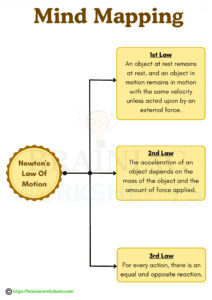
3. Cornell Method
Cornell Method of note-taking is an effective method developed by Walter Pauk (Professor at Cornell University) in the 1950s. This method is different from all other note-taking methods. In this method, the page is divided into three sections: cues section, note-taking section, and summary section.
How to create:
- Divide the page into three distinct sections, each reserved for a specific purpose. Make 2 columns – the right column will be the widest and most spacious one, and the left one will be narrow. Then make a row at the bottom section of the page (refer to the image below).
- The left column is the ‘Cues Column’ where the keywords, main concepts, brief prompts, and short questions are written that relate to the notes column. This column is the narrowest section on the page.
- The adjacent column to the Cues Column is the ‘Main Note-Taking Area’ and the largest section on the page. The primary information and main ideas are noted under this section in the form of linear bullet points, brief statements, and abbreviations.
- The bottom part of the page is the ‘Summary Section’, where the summary (gist) of the main information is written in your own words.
Benefits:
- The organized structure and clear layout make it easy to remember.
- The cues and prompts enhance retention (active recall) and encourage active learning.
- It promotes questioning and self-testing.
- It serves as a study guide that improves comprehension, identifies information gaps, and helps in quick revision with clarity.
Compatible Subjects: Lectures, textbook reading, humanities, science, maths, etc.
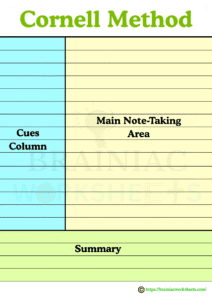
4. Outlining Method
The Outlining Method of note-taking is a hierarchical, structured approach where the information is noted on the basis of hierarchy using indentation to represent the relationship between the main ideas and their supporting information. It’s like creating a table of contents based on the information.
How to create:
- Write the main topic farthest to the left margin using Roman numerals (like I, II, III, IV).
- Indent the subtopics connected to the main topic to one level on the right. Label them using numbers or letters (1, 2, 3 / A, B, C).
- Continue further indentation (if required) for more detailed information, labeling them as i., ii., iii., or a., b., c., etc.
- Use consistent inked pens for each indentation level.
- Maintain the hierarchy properly.
- Use keywords and short phrases to keep it precise and catchy.
- Leave spaces after each level of indentation.
Benefits:
- Its logically organized hierarchical order helps to understand the relationship between main ideas and details.
- It encourages active listening and active reading.
- It naturally highlights the information due to its hierarchical structure, which is easy to revise.
- This method is very useful for essays and research papers.
Compatible Subjects: It is compatible with almost any subject where the information is presented in hierarchical progression, such as history, literature, sociology, psychology, science, maths, political science, etc.
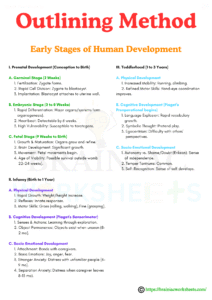
5. Charting Method
The Charting Method of note-taking is also known as the ‘Table Method’ or ‘Grid Notes’. In this method, the information is structured into rows and columns of a grid structure. This is an appropriate method to represent a huge amount of data.
How to create:
- Determine the main categories, topics, and subtopics before organizing the chart.
- Draw as many rows and columns as required.
- Fill the topmost cells (an intersection of rows and columns) with the category names and left most cells with topics and subtopics.
- Fill the rest of the cells with relevant information.
- Like every other method, use keywords and short phrases to present the information conveniently.
Benefits:
- It’s ideal for comparison purposes.
- It’s easy to revise because the information is presented in a clear and logical grid format.
- It helps to have a quick review as the information is grouped in a structured format.
- This reduces the load of text and is much more appealing.
Compatible Subjects: It is ideal for subjects that are data-heavy, fact-heavy, and involve comparison, contrast, and categorization.
Drawback: This method of note-taking is rigid, not flexible.
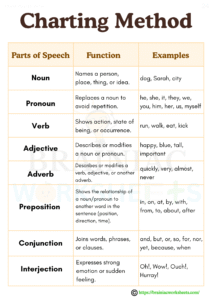
6. Boxing Method
As the name suggests, in this method, the pieces of information are written in different boxes. This approach ideally groups pieces of information based on different topics and subtopics.
How to create:
- Classify different topics before note-taking. This makes the task easier.
- Identify the core topic and related subtopics that will let you decide when you need a new box every time.
- First, write the information using keywords, bullet points, and short phrases, then draw a box around it.
- Initially, draw the boxes using a pencil. When you are finally done jotting down the entire information, use colored markers for different boxes.
- Try to maintain consistent colors for related subtopics.
- Draw lines to connect boxes of the same topic to show the relationship.
- Start a new box for every new topic.
Benefits:
- This format helps to organize the notes in a highly clear visual format.
- It helps to visually identify similar and distinct topics.
- The information seems seamless and easy to remember because it’s presented in chunks.
- This is a flexible method that allows for presenting the information in different sizes of boxes. It’s not rigid like the ‘Charting Method’.
- This approach improves clarity and boosts focus.
Compatible Subjects: This method is ideal for subjects where the information can be divided into separate and self-contained topics and subtopics. Subjects like biology, physics, history, political science, etc., are compatible.
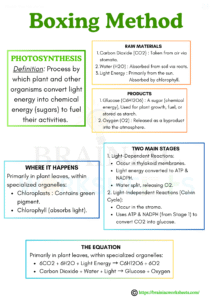
7. Flow Chart Method
The ‘Flow Chart Method’ of note-taking, also known as the ‘Flow Method’, is a free-flowing, dynamic, and non-linear approach that mainly emphasizes displaying the relationship and progression of information. This is a visual diagrammatic approach that involves the use of different geometrical shapes, such as an oval, a rectangle, and a diamond. These geometrical shapes contain different information that is connected through arrows.
How to create:
- Identify the central topic and write it.
- Use keywords or short phrases to write the subtopics and other information using shapes.
- Add the details, but keep it precise.
- Branch out more as required to continue the flow of information.
- Draw arrows to connect related ideas and topics.
- Use colors for highlighting purposes.
Benefits:
- It enhances critical thinking and develops deep understanding.
- It also helps to understand the relationship between different topics and subtopics, as the connection between them is clearly visible.
- This approach enhances long-term memory because the visual connections, shapes, symbols, and colors help in active processing and retention of information for a long time.
- This approach also encourages creativity, which makes it appealing and personalized.
- This interconnected web that represents the association between related ideas and concepts is easy to revise and recall whenever required.
Compatible Subjects: This method is adaptable to any subject where different topics and subtopics are interrelated, such as computer, biology, history, sociology, language and literature, law, business, and economics etc.
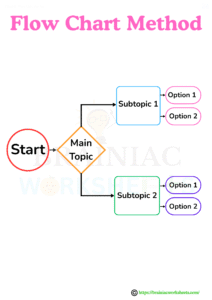
Things To Remember
- Active Engagement: It is the key to note-taking. Note-taking does not mean copying information; it involves processing, summarizing, and paraphrasing the relevant information in your own words.
- Discover the Purpose: Understand the purpose of note-taking. This develops an urge to drive your interest to make notes actively.
- Precision: Don’t write long sentences; instead, use keywords, short phrases, and bullet points.
- Practice Shorthand: Use consistent abbreviations and symbols to speed up and keep it neat.
- Space: Leave enough space to keep the notes clutter-free.
- Original Source: Always write the original source of information, like chapter/topic name, author name, page numbers, etc.
- Select the Appropriate Method: Choose the appropriate note-taking method that is ideal for the subject and your learning style. Always keep it convenient for you.
- Revision: Revise & improvise the notes as required.
How To Revise Using Notes
Now it’s time to understand how to revise the notes you have made using the above-mentioned note-taking methods.
Go through the notes of a chapter that you have read earlier. Close the notes and try to retrieve the information. This strengthens your memory.
Use the spaced repetition technique to combat forgetting. Revise your notes at increased intervals of time. This stores the information in long-term memory.
Solve different patterns of questions (MCQs, short questions, long questions, writing definitions) using the notes.
Solve PYQs (previous year questions) and competency-based questions using the notes to fill your learning gaps and gain a comprehensive understanding of the chapter/topic.
Explain the chapter/topic to yourself or someone else to master it.
Attach and connect new information with the old information to keep your notes updated.
Revision Strategies For Different Note-Taking Methods
Sentence Notes & Outlining Notes
- Use the headings and subheadings as questions. Write the questions on a separate sheet or copy, and try to write the answers without seeing the notes.
- Try to write a summary of the notes using your own words.
- Pick a heading/topic from your notes that you find most difficult and elaborate on it on a separate sheet in your own words without looking at your notes.
- Try to recall and write all the main points of the notes topic-wise.
Mind Maps (Spidergrams)
- Go through the mind map thoroughly and capture it in your brain. Now close your notes and try to draw the mind map on a separate sheet. This instigates active recall, intensifying your neural pathways.
- Try to explain each section of the mind map you have just made to yourself.
- Connect new information to your existing mind map to keep it up to date.
- Try to simplify the different sections of the mind map in your own words, and explain the connections.
Cornell Notes
- Cover the ‘Main Notes’ column & ‘Summary’ row.
- Now use the ‘Cues Column’ column on the left to question yourself and answer them verbally or write them down.
- Uncover the ‘Main Notes’ column to check the answers.
- Then try to summarize the entire content in your own words. Uncover the ‘Summary’ row and check.
- Mark the mistakes and identify the learning gaps. Again, go through the notes to fill in the gaps.
Charting Notes
- Cover the entire chart except the top-most row, which contains the main categories. Try to recall the information under each category. Then uncover the chart to check.
- Now cover the entire chart except the leftmost column, which contains the headings and subheadings. Try to recall the information against each row. Then uncover the chart and check.
- Pick a row/column and quiz yourself. Write or say the answer verbally.
- Compare the information in the chart to understand the differences, similarities, and relationships between pieces of information.
- Draw a blank chart and copy the main categories. Now, cover your notes and try to fill in the chart using active recall.
- Refer to the original notes to find out and fill in the learning gaps.
Boxing Notes
- Pick one box at a time and cover it. Then try to recall the contents of that box. You can write what you recall. Uncover the box and check.
- Now, explain the information in the box to yourself in your own words.
- Repeat this with all the boxes.
- Find the connection between different boxes and review them. Explain the connections and their relationship to yourself in your own words.
- Summarize every box.
Flow Notes
- Go through the notes quickly and cover them.
- Pick a segment from the flow chart and elaborate on it, along with the connections, by retrieving the information from your memory.
- Explain the gist of each segment to yourself. Also, explain the connections and the flow logically.
- Copy the main headings and then complete the flow chart.
Conclusion
So you have seen that note-taking isn’t about hard work (writing an endless number of pages) or calligraphy-like handwriting, it’s about smartly utilizing different note-taking methods and actively engaging with them. Choosing the ideal note-taking method is the most crucial part – be it the structured logic of sentence or outlining method, the recall power of the Cornell approach, the visual web of mind maps and flow charts, or the comparative clarity of boxing and charting method. Note-taking turns passive information into active knowledge. Follow the revision strategy for each method of note-taking and actively engage in the process. Embrace these methods, use them efficiently & effectively, and witness these notes becoming your most effective study tool, helping you not just to score well, but truly master your subjects.
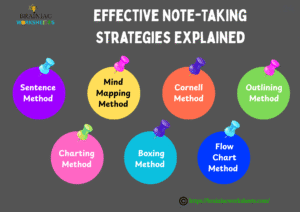
Frequently Asked Questions (FAQs)
Q: How do I turn a textbook into notes?
A: To turn your textbook into notes, go through the contents of the chapter, have a look at the headings and subheadings, read the text in chunks, paraphrase in your own words, and practice self-questioning.
Q: How to organize notes from a textbook?
A: To organize notes from a textbook, use structured methods like linear/outlining, use Cornell for active recall, mind maps for visual connections, or charting for comparisons. Take the notes in the correct chronological order.
Q: What are the 5 R’s of note-taking?
A: The 5 R’s of note-taking stand for:
- Record (write main information in points)
- Reduce (summarize the content)
- Recite (cover your notes and have a verbal recall)
- Reflect (practice critical thinking for deeper understanding)
- Review (revise to reinforce)
I hope this article was helpful.
If you have any queries, contact us or comment below.
Thank you,
Simran Mondal.


